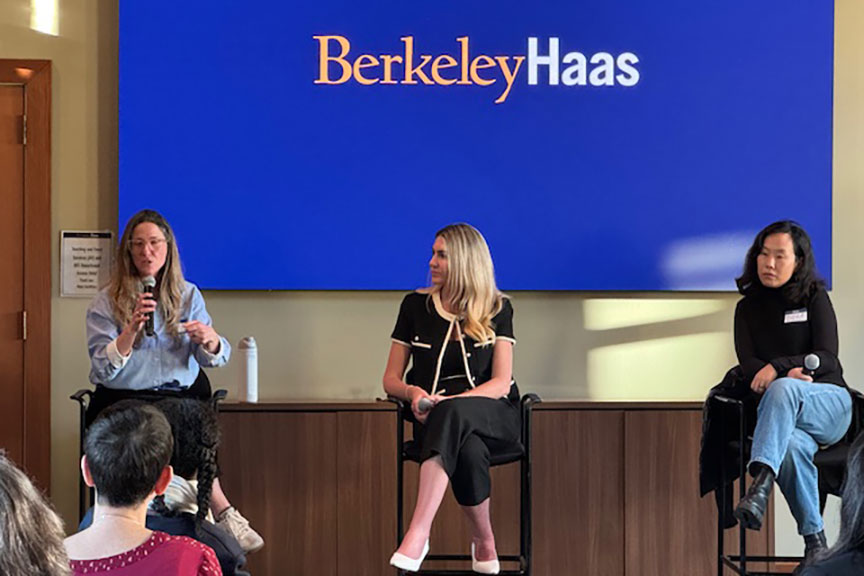By Sandra Wasicek, FWSF Programs Committee
On October 29, 2025, FWSF hosted an industry-leadership panel on stablecoins at Berkeley Haas, moderated by Professor Christine Parlour of Berkeley Haas. The panel brought together experts from regulation, entrepreneurship, and global payments: Brynly Llyr, Dora Chai, and Christina Potter.
Parlour opened by asking a deceptively simple question: what does it really mean for a digital asset to be “stable”? She noted that stablecoins—tokens designed to maintain parity with fiat currencies—represent not just a new asset class but a fundamental re-engineering of how value moves through the economy.

Brynly Llyr, Deputy Commissioner for Digital Financial Assets at California’s Department of Financial Protection and Innovation (DFPI), emphasized that “trust is the currency of finance.” While innovation can move quickly, she said, lasting adoption depends on transparency, accountability, and consumer confidence.
Llyr highlighted California’s leadership in establishing clear frameworks for digital-asset oversight, including the newly enacted Genius Act, which introduces licensing requirements for crypto and stablecoin companies. “Our goal isn’t to slow innovation,” she explained. “It’s to make sure it scales safely.” The act, she added, aims to ensure responsible growth by setting consistent, enforceable standards—allowing legitimate innovators to thrive while protecting consumers from risk.
Her remarks underscored a recurring theme: smart regulation builds trust, and trust fuels innovation.
Dora Chai, fintech founder and entrepreneur, shifted the conversation from policy to product. She described how stablecoins’ most meaningful impact will come not from speculative trading but from accessible, human-centered applications.
“Technology has to meet people where they are,” Chai said. “You can’t design for crypto insiders—you have to design for real users solving real problems.” She spoke about the importance of usability, education, and clear communication in earning user trust—especially for communities historically underserved by traditional finance.
For Chai, inclusion isn’t a side benefit of stablecoins; it’s the point. “Financial technology should make people feel empowered, not excluded,” she said.
Christina Potter, Vice President at BVNK, offered the perspective of a global payment’s innovator working at the intersection of banking and blockchain. She described stablecoins as a bridge between two financial worlds — regulated institutions and open digital networks.
Potter explained that stablecoins can dramatically streamline cross-border payments, treasury operations, and B2B transactions, reducing cost and settlement time while improving transparency. “The future isn’t crypto versus banking—it’s both,” she said. “The next generation of fintechs will succeed by connecting those systems seamlessly.”
She also emphasized that partnerships among banks, payment networks, and fintechs are accelerating, paving the way for mainstream stablecoin adoption grounded in trust and compliance.
In closing, Professor Parlour invited the panelists to reflect on what’s needed for the U.S. to remain competitive in digital finance. Llyr called for continued dialogue between regulators, innovators, and academics to avoid fragmented oversight. Chai underscored the need for financial education and accessible design, while Potter highlighted cross-sector collaboration as key to interoperability and consumer confidence.
All agreed that stablecoins signal more than a technological innovation—they represent a cultural shift toward transparency, inclusion, and shared accountability — values long championed by women leaders in finance.
Parlour closed with a challenge to the audience: “The question isn’t whether stablecoins will shape the future of money—it’s how we, as an industry and as a society, will shape the future of stablecoins.”
Why it matters for FWSF members: The Genius Act, AI-driven compliance, and stablecoin use cases (cross-border, treasury) are redefining roles in finance. Understanding the policy path and the infrastructure stack positions members to lead initiatives—not just react to them.
From Connections Newsletter (Past Event Highlights): November 2025
––––––––––––––––––––––
The suggestions of the contributor do not constitute professional advice and are intended for general informational and educational purposes only. Nothing contained herein is intended to be or should be used as a substitute for professional advice, and readers should not act or rely on this information without seeking specific guidance directly from a qualified professional.
The opinions and information expressed in this blog/post/webpage are solely those of the contributor and do not necessarily reflect the views of FWSF. FWSF is not responsible for any errors or omissions in this content or any damages resulting from its use.